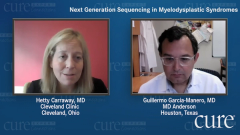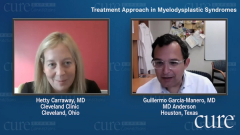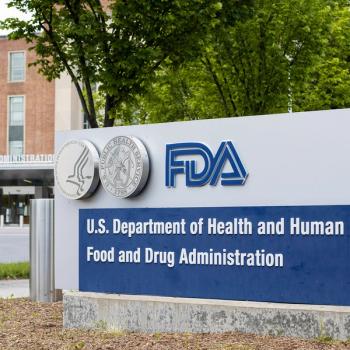
An Overview of Myelodysplastic Syndromes
Episodes in this series

Hetty Carraway, MD: Hello, and welcome to CURE EXPERT CONNECTIONS®. I’m Dr. Carraway from the Cleveland Clinic, and I’d like to welcome my colleague, Dr. Guillermo Garcia-Manero from The University of Texas MD Anderson Cancer Center. Today we are going to discuss myelodysplastic syndromes, what a patient journey of this diagnosis looks like, as well as treatment, management, and novel agents in treating MDS [myelodysplastic syndrome] with anemia. Welcome, Dr. Garcia-Manero. Good morning.
Guillermo Garcia-Manero, MD: Good morning. Please call me Guillermo, Dr. Carraway.
Hetty Carraway, MD: Let’s start with talking about the presentation of myelodysplastic syndrome. I’m going to start by launching the first question. Can you provide a brief overview of MDS for our patients and caregivers?
Guillermo Garcia-Manero, MD: Myelodysplastic syndrome, or MDS, represents a very heterogeneous group of disorders of the bone marrow. The disease is really diverse. It could range from a very indolent disorder, which may take many years to cause any problems for the patients, to very aggressive disease that could be as fast as acute leukemia. Basically, we use different classifications to determine these different subtypes, and we base our risk prognostic scoring system on a number of factors: things like the percentage of blasts, chromosomal abnormalities, and more recently genetic or molecular alterations that are really helping us determine the prognosis and type of therapy for our patients. It is crucial that when a patient is diagnosed with this condition, he or she understands the specific subtype and what the characteristics of the diagnosis are, because that’s going to make a major difference in terms of how we approach this disease.
Hetty Carraway, MD: Are there any risk factors that patients or caregivers should know about with regard to being somebody that might be diagnosed with MDS?
Guillermo Garcia-Manero, MD:Yes. Unfortunately, the major risk factor is something that we cannot avoid: age. This is a disease that is more frequent in older individuals, especially once you pass 70 years of age. We consider that a large majority of patients are suffering from disease because of the aging process in the stem cell in the bone marrow. There are some other risk factors. We know that there are some toxic exposures that could be associated with earlier development of these diseases. There are some patients with prior cancers who develop something we now call therapy-related leukemias or therapy-related MDS. These are patients who had other treatments for some other cancers. In my hospital, this is not uncommon in patients with myeloma or lymphoma who received an autologous stem cell transplant. Unfortunately, many years later, they can develop this secondary type of leukemia.
In the last few years, we have learned that there is some genetic background where this disease can be inherited through family through specific genes. Most hospitals that take care of these patients, like the Cleveland Clinic, already have genetic screening programs that are helping us identify this rare, but not infrequent, subset of patients who have a family history of these myelodysplastic syndromes. In summary, aging is the major risk factor for the vast majority, but exposure to chemicals, therapy-related disease, and—for some families—genes may predict development of this type of disease.
Hetty Carraway, MD: That’s a fantastic overview. When patients typically present with MDS, what does that usually look like? When you see patients, how is it that they come to your attention?
Guillermo Garcia-Manero, MD: This has changed over the years, and I wonder if it’s the same thing at the Cleveland Clinic. Most recently, what we’re seeing is that on our routine follow-up for an annual physical examination or something like that, the primary care doctor or internist notices that the blood counts in the peripheral blood on a regular CBC [complete blood count] are a little abnormal. That triggers referral to a hematologist, who will then do a bone marrow test. That is the most common presentation here. It is not uncommon for the patient to present to the doctor because he or she is fatigued, has anemia, or notices some easy bruising possibly caused by the platelets being low. Sometimes, the patient presents with an unexplained infection that is a result of a low white blood cell count. But most of our patients are incidentally diagnosed at a regular checkup with a doctor. Things to look for would be fatigue, easy bruising, fever, and unexplained infection.
Hetty Carraway, MD: That’s definitely been our experience as well, Guillermo: patients being identified because of an annual physical exam. Some patients that are active start to notice that during the normal routine things they always do regularly, they need to stop and rest. Those scenarios usually come to our attention, and then patients have an abnormal CBC and get worked up. All the things you’re describing are recapitulated with our experience at the Cleveland Clinic as well.
Guillermo Garcia-Manero, MD: What is interesting is that if you ask the patients, many times the symptoms started just a few weeks before presentation. But sometimes patients will tell you they’ve had these symptoms for months or even a couple of years before they come. It can be so smoldering or indolent that some of these patients can have a very slow progression over a long period of time.
Hetty Carraway, MD: I definitely agree. It’s pretty uncommon for patients to present with overt signs of the disease or active bleeding. Typically, when that happens, it’s a quicker pace, and that’s pretty infrequent. The majority of patients with myelodysplastic syndrome are going to land in the scenario where they’re at a lower risk of myelodysplastic syndrome, and we’re finding that there’s been this gradual onset of some issue with cytopenia, whether that’s a lower platelet count, a lower hemoglobin, or a lower white blood cell count.
Transcript Edited for Clarity
















